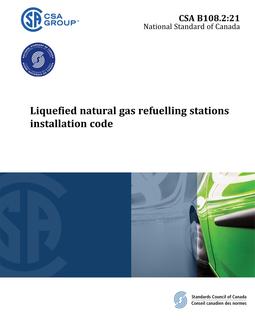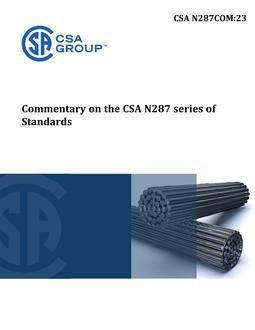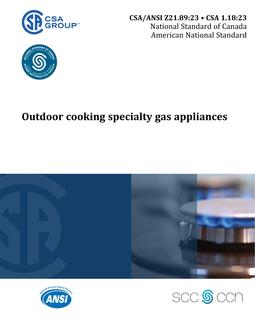
CSA B108.2:21
- Comments Off on CSA B108.2:21
- CSA
Click here to purchase
Preface:
This is the first edition of CSA B108.2, Liquefied natural gas refuelling stations installation code. It supersedes the previous edition published in 2018 as Part 2 of CSA B108, Natural gas refuelling stations installation code.
CSA B108.1 is applicable to compressed natural gas (CNG) refuelling stations. CSA B108.2 is applicable to liquefied natural gas (LNG) refuelling stations, including LNG to CNG conversion systems. This Code supersedes Annex D of CSA Z276, Liquefied natural gas (LN) — Production, storage, and handling.
Significant changes to this edition include the following:
a) reorganized content for consistency of organization between this Code and CSA B108.1;
b) clarification of definitions, and requirements to include distinction between residential fuelling appliances (RFAs) and listed non-residential vehicle fuelling appliances (VFAs);
c) added coverage for defuelling;
d) added coverage for mobile refuelling units and portable refuelling units;
e) added reference content for risk assessment;
f) added coverage for CNG stations where feedstock is liquefied natural gas (L/CNG refuelling stations); and
g) editorial revisions to clarify wording and references, tables and figures, resolve conflicts identified with other documents, provide consistency and clarification between this Code and CSA B108.1, correct metrication values, and harmonize definitions with other industry codes and standards.
CSA Group acknowledges that the development of this Standard was made possible, in part, by the financial support of Natural Resources Canada.
This Code has been developed in compliance with Standards Council of Canada requirements for National Standards of Canada. It has been published as a National Standard of Canada by CSA Group.
Scope:
1.1 Inclusions
This Code applies to
a) the design, location, construction, operation, operator training, and maintenance of LNG refuelling stations, including LNG mobile refuelling units (MRUL), with single containment storage tanks up to 265 m3 (70 000 gal) water capacity employed for vehicle LNG dispensing operations;
b) shop-fabricated and assembled refuelling stations when used to receive and store LNG to dispense LNG into vehicle fuel tanks; and
c) the LNG portion of stations that vaporize and pressurize LNG to obtain CNG, up to and including the odorizer’s outlet isolation valve. When a refuelling station dispenses fuels in addition to LNG, this Code applies only to the LNG refuelling system and equipment.
1.2 Exclusions
This Code does not apply to:
a) indoor refuelling;
b) marine vessel LNG fuelling facilities;
c) rail locomotive LNG fuelling facilities;
d) equipment, piping, or tubing downstream of the L/CNG system odorizer’s outlet isolation valve (see CSA B108.1);
e) CNG equipment including storage, compression, and/or dispensing equipment;
f) CNG mobile refuelling units (MRUG) or CNG portable refuelling units (PRUG);
g) equipment, piping, or tubing downstream of the gas pressure regulator for closed boil-off gas systems;
h) dispensing of LNG other than into vehicle or cargo fuel tanks;
i) liquefaction equipment;
j) LNG engine fuel systems;
k) LNG and CNG repair garages;
l) underground piping or tubing for LNG;
m) LNG storage tanks, pumps, and process piping or tubing when an LNG refuelling station is sharing the LNG plant storage tank; and
n) transfer of LNG from the LNG vehicle fuel storage system of one vehicle to the LNG vehicle fuel storage system of another vehicle. This does not apply to a bulk fuel storage system.
1.3 Pressure terminology
All references to pressure throughout this Code are to be considered gauge pressures, unless otherwise specified.
1.4 Terminology
In this Code, “shall” is used to express a requirement, i.e., a provision that the user is obliged to satisfy in order to comply with the Code; “should” is used to express a recommendation or that which is advised but not required; and “may” is used to express an option or that which is permissible within the limits of the Code. Notes accompanying clauses do not include requirements or alternative requirements; the purpose of a note accompanying a clause is to separate from the text explanatory or informative material. Notes to tables and figures are considered part of the table or figure and may be written as requirements. Annexes are designated normative (mandatory) or informative (non-mandatory) to define their application.
1.5 Use of SI units
The values given in SI units are the units of record for the purposes of this Code. The values given in parentheses are for information and comparison only.
Product Details
- Edition:
- 1st
- Published:
- 01/01/2021
- ISBN(s):
- 9781488334979
- Number of Pages:
- 91
- File Size:
- 1 file , 1.2 MB
- Product Code(s):
- 2428897, 2428897



